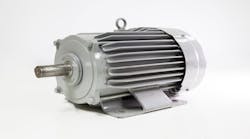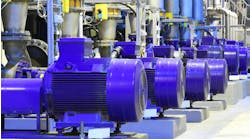When designing electrical equipment in hazardous (classified) locations, it is extremely important to specify the correct equipment due to the gases, dusts, or fibers that may be present in the air. In petrochemical plants, the most prevalent designation of hazardous area classification (HAC) within a process unit is Class I, Division 2, which indicates that there may be combustible gases or vapors in sufficient quantities under abnormal conditions to create an ignition. National Electrical Code (NEC) Art. 500 addresses hazardous (classified) locations generally, and NEC Art. 501 covers Class I areas specifically.
Some common types of electrical equipment you may find in a petrochemical process unit subject to HAC considerations are luminaires, switches, breakers, fuses, control devices, and motors. This article will only touch on the caveats of motors in Class I, Division 2 locations.
Motors in Class I locations are covered in Sec. 501.125. When motors are in Class I, Division 2 locations, the rules are not as stringent as those found in Division 1 locations, since these areas are not expected to experience explosive atmospheric conditions under normal operating conditions. Section 501.125(B) covers the rules for motors in these atmospheres. The first type of motor that’s allowed is one that is identified for Class I, Division 2 locations. Sometimes, small motors (480V and less) carry this identification, but often small motors are of the totally enclosed, fan-cooled (TEFC) type, which is allowed in 501.125(B)(3) if there are no arcing parts such as centrifugal switches or capacitors.
Problems can arise sometimes when TEFC motors are installed without consideration of the T-Code for the area. Informational Note No. 1 in Sec. 501.125 alludes to this problem, but doesn’t explain it in detail since the Code is not intended to be a design specification or an instruction manual for untrained persons [90.1(A)].
Though TEFC motors typically don’t have a T-Code stamped on the nameplate with the maximum surface temperature, internal and external temperatures of the motor must be considered. IEEE Std. 841, IEEE Standard for Petroleum and Chemical Industry — Premium-Efficiency, Severe-Duty, Totally Enclosed Fan-Cooled (TEFC) Squirrel Cage Induction Motors — Up to and Including 370kW (500 HP), Section 5.4.2, states: “Temperature Rise ― When operated at rated voltage, frequency, and power, the average temperature rise of any phase of the stator winding shall not exceed 80°C as determined by the winding resistance method. Maximum exposed internal and external surface temperatures shall not exceed 200°C under typical service conditions at 1.0 service factor (SF).” Looking at NEC Table 500.8(C), a maximum 200°C temperature is equivalent to a T3 rating. It isn’t unusual though, in a petrochemical plant, to have areas where the T-code is T3A-T3C. In these cases, normal TEFC motors may run too hot and cannot be used.
The surface temperature of any motor space heaters installed for the prevention of condensation must also be considered in hazardous locations [See Sec. 501.125(B)(4)].
© 2018 Fluor Corporation. All Rights Reserved.



